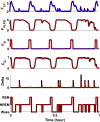Model-based analysis and forecast of sleep-wake regulatory dynamics: Tools and applications to data
- PMID: 33754773
- PMCID: PMC7837756
- DOI: 10.1063/5.0024024
Model-based analysis and forecast of sleep-wake regulatory dynamics: Tools and applications to data
Abstract
Extensive clinical and experimental evidence links sleep-wake regulation and state of vigilance (SOV) to neurological disorders including schizophrenia and epilepsy. To understand the bidirectional coupling between disease severity and sleep disturbances, we need to investigate the underlying neurophysiological interactions of the sleep-wake regulatory system (SWRS) in normal and pathological brains. We utilized unscented Kalman filter based data assimilation (DA) and physiologically based mathematical models of a sleep-wake regulatory network synchronized with experimental measurements to reconstruct and predict the state of SWRS in chronically implanted animals. Critical to applying this technique to real biological systems is the need to estimate the underlying model parameters. We have developed an estimation method capable of simultaneously fitting and tracking multiple model parameters to optimize the reconstructed system state. We add to this fixed-lag smoothing to improve reconstruction of random input to the system and those that have a delayed effect on the observed dynamics. To demonstrate application of our DA framework, we have experimentally recorded brain activity from freely behaving rodents and classified discrete SOV continuously for many-day long recordings. These discretized observations were then used as the "noisy observables" in the implemented framework to estimate time-dependent model parameters and then to forecast future state and state transitions from out-of-sample recordings.
Figures













Similar articles
-
Reconstructing mammalian sleep dynamics with data assimilation.PLoS Comput Biol. 2012;8(11):e1002788. doi: 10.1371/journal.pcbi.1002788. Epub 2012 Nov 29. PLoS Comput Biol. 2012. PMID: 23209396 Free PMC article.
-
Physiologically-based modeling of sleep-wake regulatory networks.Math Biosci. 2014 Apr;250:54-68. doi: 10.1016/j.mbs.2014.01.012. Epub 2014 Feb 11. Math Biosci. 2014. PMID: 24530893 Review.
-
Critical Dynamics and Coupling in Bursts of Cortical Rhythms Indicate Non-Homeostatic Mechanism for Sleep-Stage Transitions and Dual Role of VLPO Neurons in Both Sleep and Wake.J Neurosci. 2020 Jan 2;40(1):171-190. doi: 10.1523/JNEUROSCI.1278-19.2019. Epub 2019 Nov 6. J Neurosci. 2020. PMID: 31694962 Free PMC article.
-
Coupled flip-flop model for REM sleep regulation in the rat.PLoS One. 2014 Apr 10;9(4):e94481. doi: 10.1371/journal.pone.0094481. eCollection 2014. PLoS One. 2014. PMID: 24722577 Free PMC article.
-
[Selective stimulations and lesions of the rat brain nuclei as the models for research of the human sleep pathology mechanisms].Glas Srp Akad Nauka Med. 2011;(51):85-97. Glas Srp Akad Nauka Med. 2011. PMID: 22165729 Review. Serbian.
Cited by
-
Optimization of an unscented Kalman filter for an embedded platform.Comput Biol Med. 2022 Jul;146:105557. doi: 10.1016/j.compbiomed.2022.105557. Epub 2022 May 7. Comput Biol Med. 2022. PMID: 35598350 Free PMC article.
References
-
- Datta S. and MacLean R. R., “Neurobiological mechanisms for the regulation of mammalian sleep-wake behavior: Reinterpretation of historical evidence and inclusion of contemporary cellular and molecular evidence,” Neurosci. Biobehav. Rev. 31, 775–824 (2007). 10.1016/j.neubiorev.2007.02.004 - DOI - PMC - PubMed
MeSH terms
LinkOut - more resources
Full Text Sources
Other Literature Sources

